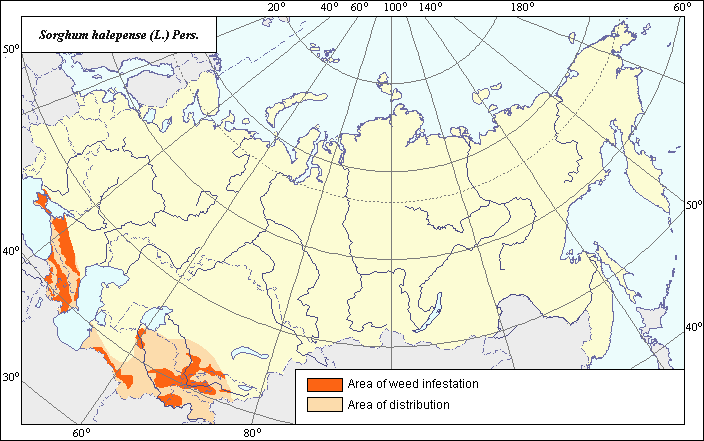Weeds
Area of distribution and weediness of Sorghum halepense (L.) Pers.
 Object description Download GIS-layers
Object description Download GIS-layers
Authors:
Specialist-biologist T.D. Sokolova,GIS-specialist I.A. Budrevskaya.
Date of creation:
30.06.2006.Scale:
1:20 000 000.Accuracy of the map:
It is created on materials of maps of natural scale 1:5 000 000 - 1:100 000 000 and on literature data.Projection:
"Alber's Equal Area Conic" USSR, 9, 1001, 7, 100, 0, 44, 68, 0, 0.Basic contents:
Vector map. Area is shown by polygons (main distribution) and by dots (sporadic distribution). Zone of weediness is shown by polygons.Accuracy of the classifier:
The zones of main and sporadic distribution and the zone of weediness are shown within the weed area where S. halepense is a pernicious weed. The zone of weediness is established by criteria of occurrence of this species and abundance (Tanskii V.I. et al., 1998). In the limits of this zone, S. halepense is characterized by 75-100% frequency of occurrence and 5 points of abundance.Method of map production:
Areas of main distribution, sporadic distribution and weediness are established according to the analysis of the open published maps and literature. The area of S. halepense is based on the map taken from Volkov A.N. (1935). Data of Grossgeim A.A. (1939) confirm S.halepense distribution in the Caucasus. Limits of the zone of weediness are established according to Nikitin V.V. (1979; 1983) and Ulyanova T.N. (1998), being specified in accordance with data on abundance and frequency of the species occurrence, which are taken from the following references, and adjusted to the limits of arable lands. According to Nikitin V.V. (1979; 1983) and Ulyanova T.N. (1998), S.halepense is included in the list of the most pernicious weeds of worldwide agriculture; on the territory of the former USSR it is widespread in Central Asia and South Kazakhstan, in the Northern Caucasus and Transcaucasia, rarely occurring in the South of the European part.Reference citations:
Anon. 1996. Weeds on sugar beet. Berlin: Hoehst Shering AgrEvo Gmbh., 479 p. (in Russian).Dadabaev, A.D., ed. 1971. Herbicides application in the cotton-growing region of Uzbekistan. Tashkent: FAN, 232 p. (in Russian).
Grossgeim, A.A. 1939. Flora of the Caucasus. V. 1. Baku: AzFan, 402 p. (in Russian).
Keller, B.A., ed. 1934. Weed plants of the USSR. V. 1. Leningrad: AN SSSR. 324 p. (in Russian).
Nikitin, V.V. 1979. Geographical distribution of the most important weed species of the USSR and their dynamics. Botanicheskii zhurnal. 64(7): 943-949 (in Russian).
Nikitin, V.V. 1983. Weed plants in the flora of the USSR. Leningrad: Nauka, 454 p. (in Russian).
Nikonov, A.A., ed. 1975. Weed plants of the Stavropol Territory. Proc. Stavropol NIISKH, Stavropol: NIISKH, 292 p. (in Russian).
Rozhevits, R.Yu., Shishkin, B.K., eds. 1934. Flora of the USSR. V. 2. Leningrad: AN SSSR, 778 p. (in Russian).
Tanskii, V.I., Levitin, M.M., Ishkova, T.I. & Kondratenko, V.I. 1998. Phytosanitary diagnostics in integrated management of cereals. In: Novozhilov, K.V., ed. Compendium of methodical recommendations in plant protection. St.-Petersburg: VIZR, p. 5-55 (in Russian).
Ulyanova, T.N. 1981. Weed plants in wheat of the USSR. In: Korovina, O.N., ed. Catalogue of VIR world collection. Issue 320. Leningrad: VIR, 68 p. (in Russian).
Ulyanova, T.N. 1998. Weed plants in the flora of Russia and other CIS states. St.-Petersburg: VIR, 344 p. (in Russian).
Vasilchenko, I.T., ed. 1953. Weed plants of Tajikistan. V. 1. Moscow-Leningrad: AN SSSR, 451 p. (in Russian).
Volkov, A.N., ed. 1935. Areas of distribution of the major weed plants in the USSR. Moscow & Leningrad: State Publishing House of Kolkhoz and Sovkhoz Literature, 152 p. (in Russian).

